When it comes to plowing snow. both commercially and on a farm, both tractors and skid loaders are equipment you can use to your advantage. Whether you already have both and need to choose one to use for plowing, or you’re trying to decide which direction you’d like to go for your fleet, it’s important to consider the pros and cons of both a tractor snow plow and a skid steer snow plow.
One important consideration is that while choosing the right snow plow for equipment such as skid steers and wheel loaders often is dependent on the weight of the machine, picking the right tractor snow plow involves taking into consideration the horsepower of the machine.
Tractors historically are designed to perform heavy farm work, dating as far back as the 1800s. These machines pack a lot of power and are generally designed to be used for hours on end. Skid steers entered the picture roughly a century later, also designed initially for farm use, often in more confined areas. One subset of a skid steer, known as a compact track loader, operates on tracked treads, rather than tires.
Below we’ll identify which is better, the skid steer or tractor, in the following areas:
- Price
- Power
- Visibility
- Comfort
- Versatility
- Maneuverability
- Stacking
- Speed
- Storage
- Fuel
Which is more affordable – skid steer or tractor snow plow?
The Tractor.
One of the biggest advantages of a tractor over a skid steer is the lower cost in terms of power-to-size ratio. Tractors also come in many more sizes than skid steers and weight significantly less (around 35% less) than skid steers with similar horsepower, which drastically affects the pricing.
- It’s not hard to find a basic new compact tractor (approximately 25-75 horsepower) for between $10,000 and $30,000. Used models generally go for half of that. Depending on how many bells and whistles you add on and which brands or models you choose, it is possible to find compact tractors in upwards of $60,000.
- A new garden tractor (roughly 1-20 hp) can generally be acquired for less the $5,000.
- Expect to pay between $25,000 and $70,000 for mid-size utility tractor (around 70-150 hp).
- Large ag tractors (more than 150 hp) can run in excess of $120,000.
A new skid steer generally costs between $25,000 and $55,000. Even older or high-models can easily command a $10,000 to $20,000 price tag. Skid steers do come in different sizes as well with the biggest still being less than 12,000 pounds and having under 110 horsepower.
Which has more power?
The Tractor.
As mentioned above, tractors offer a significantly better power-to-size ratio. Where even the most powerful skid steer max out at about 110 horsepower, the enormous range of options of tractor sizes give tractors an even larger edge in the power department – with some tractors exceeding 700 hp.
This gives tractors much greater ability to push larger and heavier loads of snow than a skid steer.
Which has better visibility?
Depends.
When it comes to all-around visibility, the tractor wins hands down. Combine the fact the you are sitting higher with the lack of peripheral obstructions to you’re view, it’s much easier to take in the overall surroundings. However, tractor engines are in front of the cab, meaning the hood will block some of your view straightforward.
Skid steers, on the other hand have a direct line of sight at the plow itself, so it is easier to see your cutting edge. Precision work is also a little easier as you can lift the plow and look under it easily to get a full view in front of the blade. The blade or box is also pulled in much tighter to the cab, allowing the operator to get a better view over the plow when pushing – depending on the height of the plow. The view to the sides and rear are much more obstructed, which is why some skidders feature backup cameras.
Which has more comfort features?
The Tractor.
Again, the compact nature of the skid steer has limitations, including cab size. Most skid steer cabs are quite confined in space when compared to tractors. With that being said, there are skid steers with many comfort features including pressurized cabs, heated seats, seat suspension, radio, heat and air conditioning.
As with visibility, comfort options increase with the size of your tractor. While not all tractors (or skid steers for that matter) have an enclosed cab, they do offer more in terms of roominess. Larger tractors can even offer space and seating for passengers! In addition to all of comfort features of the skid steer, you may even find features such as USB Ports, 12V outlets, lumbar support, handrails, footrests, refrigerators and tilting steering columns.
Which has better versatility?
Depends.
A skid steer has the ability to switch attachments more quickly and easily and likely has more attachment options while a tractor with a PTO and/or rear hitch gives the options to put two attachments to work at the same time.
For instance, when using a skid steer, you can use a KAGE SnowFire 2-in-1 plow and pusher system to clear snow from a parking lot, then quickly remove the plow and, using the quick attach system, attach at KAGE LiquidRage brine sprayer and spray the parking lot to prevent ice.
You could also use those same two attachments on a tractor, putting the SnowFire system on the front and attaching the LiquidRage to the 3-point hitch in the rear at the same time. This may require slightly more time for initial setup, but save you time on switching attachments.
For larger tractors, some snow removal professionals like to have a plow in the front and hook up a snowblower or salt spreader to the PTO in the back. Another option for large tractors would be to, instead of having a snow blower in the back, install a rear mounted wing blade such as KAGE’s Shadow blade. This would provide the ability to bench wing or plow wider swaths without making additional passes.
Which has better maneuverability?
Skid Steer.
Without question, the skid steer hold the advantage here. Tractors steer through their front tires while skid steers can turn within their own footprint in “zero-turn” style. This is achieved by independently driving the wheels or tracks on each side at different speeds or in opposite directions. Tractors typically require more space to turn, making skid steers more agile, especially in confined areas.
Skid steers can pivot around a point, allowing them to make sharp turns and change direction rapidly. This versatility makes them well-suited for tasks that involve frequent changes in direction. Tractors, on the other hand, have a generally longer wheelbase and require a larger turning radius.
Now if you take into account the loader arms, that give another point in favor of the skid steer. Tractor loader arms are flimsy in comparison to skid steer loader arms. Plus, if you place a snow plow on the end of tractor loader arms, that plow is much farther in front of the cab than in a skid steer, which pulls weight off of the back tires of the tractor and reduces its traction. The front tire steering also makes it more difficult pull a plow extended out in front with the tractor as it turns.
In short, if you need to make sharp turns while pushing snow, a tractor is not a good option, but a skid steer is designed to handle this beautifully.
Which stacks better?
Skid Steer.
As mentioned above, tractor loader arms are much flimsier than skid steer loader arms. They also respond much more slowly that skid steere loader arms. This plays a big role in the stacking of snow.
To combat the flimsy arms, many tractor snow plows, such as the KAGE SnowStorm, are mounted to a front 3-point hitch. Tractors with plows mounted in this way simply aren’t able to lift the snow blades and pusher boxes has high as skid steers due to the need for extra reinforcement to support the plow.
Which offers better travel speed?
Tractor
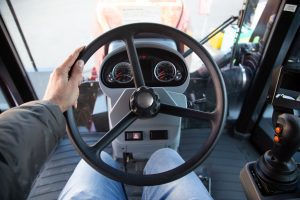 If you are plowing long straight stretches, such as roads or long driveways, you’ll definitely find using a tractor plow advantageous. The same goes for plowing properties that have significant separation from each other – such as rural residential areas.
If you are plowing long straight stretches, such as roads or long driveways, you’ll definitely find using a tractor plow advantageous. The same goes for plowing properties that have significant separation from each other – such as rural residential areas.
Skid Steer travel speed tends to max out around 12 miles per hour. While this is plenty for plowing most small spaces, it can be pretty slow for long stretches and when moving from one property to the next – especially if the properties are not adjacent to each other. If you need a little extra speed from your skid steer, you can always swap out for larger diameter tires, such as the KAGE Klawz snow tires. This will get you a couple more mph.
This is where tractors really excel, however, as most modern tractors can travel at up to 25 mph. If you’re not actually pushing snow and are just relocating from one job to the next, some functional work tractors can even break the 30 mph mark. (We’re not talking racing tractors that top out at over 150 mph here. Easy Tiger!)
What about storage?
Skid Steer
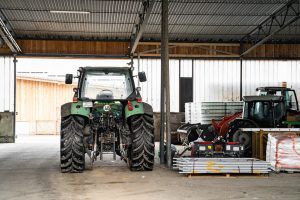 While it’s not an absolute necessity to park your tractor or skid steer indoors, keeping it out of the elements will keep your machine looking nicer longer and will likely increase its lifespan.
While it’s not an absolute necessity to park your tractor or skid steer indoors, keeping it out of the elements will keep your machine looking nicer longer and will likely increase its lifespan.
The nice thing about skid steers’ compact design is that you can park them pretty much anywhere you can park a car. Most skid steers are less than 6 feet wide and less than 13 feet long. (The average car is approximately 5.8 feet wide and 14.7 feet long.) Skid steers are a bit taller than a car, however, generally measuring between 6 and 8 feet in height, compared to the 5-6 foot average car height.
Do keep in mind that most two-car garages feature overhead doors that are 7-8 feet high, so you’ll want to be certain than you’re skid steer will clear that height if you choose to park it in a standard garage.
On the other hand, tractors vary significantly in all three dimensions (width, length, height). One thing that is consistent is that they are generally taller than skid steers – especially when they have enclosed cabs. So, parking in a standard residential garage is not usually an option.
Which has the most/best fuel options for cold weather?
Both.
This is where things get really interesting. Both tractors and skids steers are capable of operating on a wide variety of fuels (granted not within the same machine).
 There are tractors designed to run on the following 6 types of fuels.
There are tractors designed to run on the following 6 types of fuels.
- Gas
- Diesel & Biodiesel
- Kerosene
- Propane
- Electricity
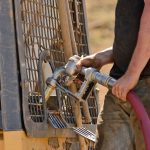 Skid steers, on the other hand, have been designed to run on just 4 fuel sources:
Skid steers, on the other hand, have been designed to run on just 4 fuel sources:
- Diesel
- Propane
- Electricity
- Gas
Please note that the above lists, do not indicate that you can put any of these fuels in any of the corresponding machine types.
Below we’ll break down the pros and cons of each fuel type.
 Gas Tractors & Skid Steers
Gas Tractors & Skid Steers
- Easier and cheaper to maintain than diesel
- Easier to start in cold weather than diesel
- Lower initial cost that diesel
- Smoother, quieter engine than diesel
- Most readily available fuel source
- Faster acceleration than diesel
- More power than propane, less than diesel
- More fuel efficient than propane, less than diesel
 Diesel Tractors & Skid Steers
Diesel Tractors & Skid Steers
- More power/torque than gas & propane
- Higher fuel efficiency/lower emissions than gas
- Longer engine lifespan than gas
- Higher resale value than gas
- Can be hard to start in cold weather
- Propane Tractors & Skid Steers
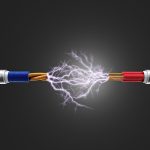 Electric Tractors & Skid Steers
Electric Tractors & Skid Steers
- Zero emissions
- Lower operating costs than diesel
- Lower maintenance costs than internal combustion engines
- Quiet Operation
- Energy Efficient
- Limited run times
- Limited charging infrastructure
- Downtime during charging
- High upfront cost
- Battery size and weight may affect weight distribution.
- Limited power and torque
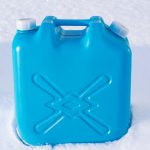 Kerosene Tractors
Kerosene Tractors
- Long runtimes
- Kerosene stores better and longer than gas
- Kerosene has lower flammability than gas
- Reliable fuel source in adverse conditions
- Low fuel efficiency
- High emissions
- Can be hard to start in cold weather
- Can be expensive fuel source
- Limited options/availability
Based on the above factors, gas tractors will prove to be the most reliable for plowing snow in cold weather. However, if you are drawn to the benefits of diesel tractors, you are in luck as there is diesel fuel available that has been improved with additives to prevent it from gelling in cold weather. This fuel is known as winter diesel, alpine diesel, or winter blend.
No matter which type of fuel your machine runs in, it would benefit from being parked indoors during extremely cold weather.
With all the information we’ve presented here, you can see that there are places for both skid steers and tractors in snow removal. The tractor wins 4of these head-to-head battles, the skid steer, three, and there is a draw on three. It’s just a matter of what is most important to you.

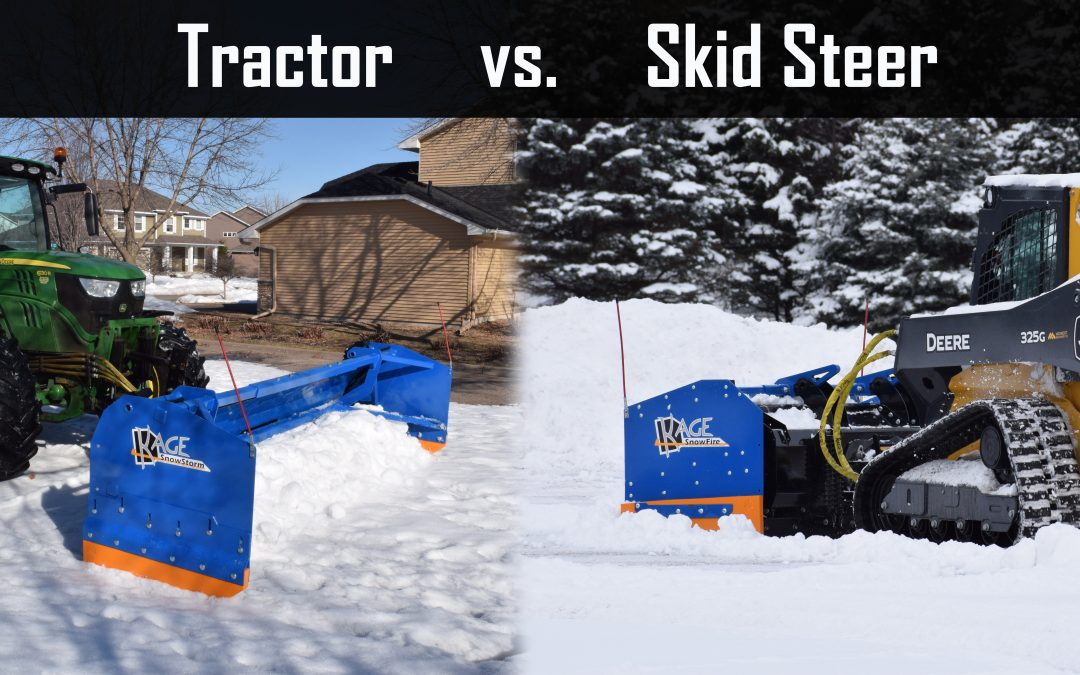




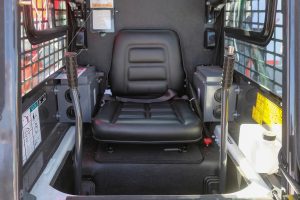
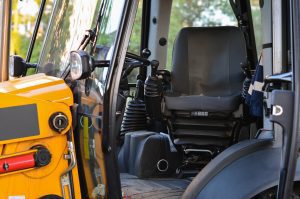

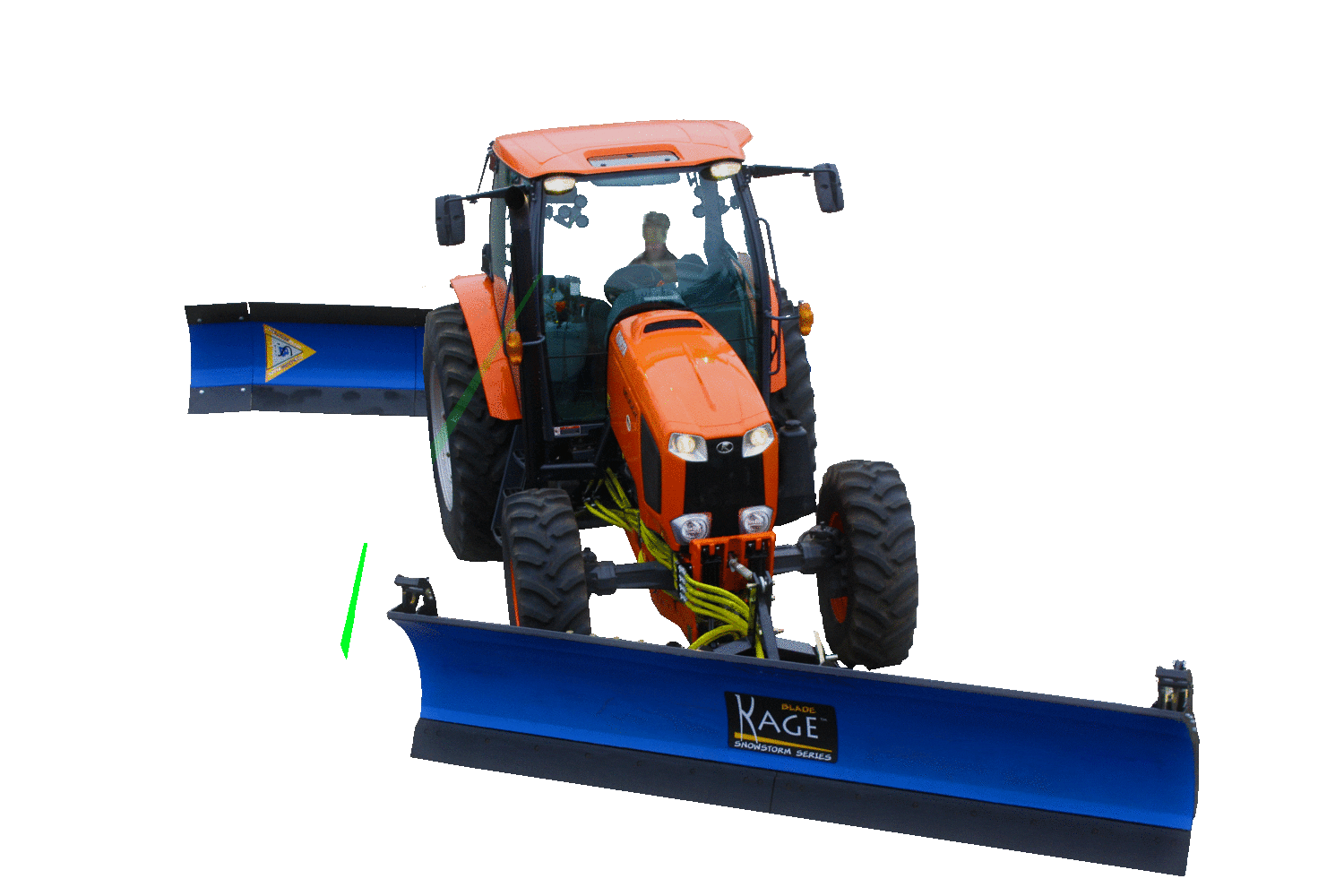
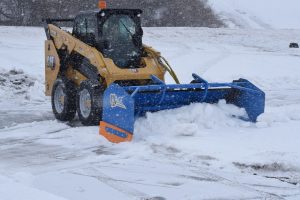

Recent Comments